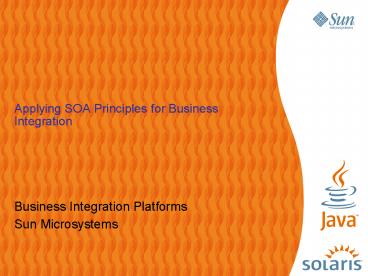Applying SOA Principles for Business Integration - PowerPoint PPT Presentation
1 / 20
Title: Applying SOA Principles for Business Integration
1
Applying SOA Principles for Business Integration
- Business Integration Platforms
- Sun Microsystems
2
Agenda
- Clarifying a few myths about SOA and Web Services
- Presenting the benefits of SOI
- Encouraging the use of open technologies and open
standards to enable SOI - Developing an ecosystem of technology partners to
enable Service Oriented Integration - QA
3
SOA and Web Services are not synonymous.
- The essential concept of SOA i.e., the use of
modularity and cloaking to create readily
reusable software components goes back more
than 30 years. - Use of the term SOA goes back at least 15
years. In the early 90s, Tuxedo applications
were built on a Service Oriented Architecture
using multiple services. - Web services only appeared 5-6 years ago.
- You can build an SOA today without using Web
services - Indeed, there are drawbacks to using Web services
in many SOA contexts. - You can use Web services without implementing an
SOA - Many Web services connections are point-to-point
links.
4
An SOA delivers flexibility through loose
coupling.
5
Within an SOA, loosely coupled is not the same
as uncoupled.
- Trade press articles suggest that SOAs loosely
coupled approach to service connectivity allows
free and easy replacement of one service with
another. - This ignores the multiple issues related to data
and process semantics that must be addressed
prior to implementing a link between programs
written at different times by different people
for different purposes. - For the same reason, the time when applications
will spontaneously connect to previously unknown
business services is far in the future. - Data semantics prevent many ad hoc connections
from being implemented without out-of-band
discussions. - Process semantics i.e., business context issues
also limit opportunities for spontaneous
integration.
6
The current Web services standards are a Work In
Progress.
- We must distinguish between Web services
technologies and Web services standards - Its entirely possible to implement
run-the-business applications using various Web
services technologies - However, this may require concessions to the
limitations of the Web services technologies
e.g., hardware accelerators may be needed to
enable high performance XML processing - If you expect plug-and-play interoperability,
then the current Web services standards will be a
disappointment - There are too many gaps, ambiguities and options
in the current Web services standards to permit
plug-and-play interoperability - For example, WS-Security allows use of User
IDs/Passwords, X.509 digital certificates or
Kerberos tickets. So, you can't assume a
consistent security implementation among several
potential Web services providers, even though
they all are WS-Security compliant.
7
The WS- standards only address interoperability
they don't address all the other requirements for
integration.
8
Service Oriented Integration takes a practical
approach to business integration challenges
- Builds on SOA principles
- Applies Web services and open standards where
appropriate - Avoids monolithic solutions by building on a
pluggable service oriented integration
architecture
9
An ESB is critical to the implementation of an
SOA.
- An ESB is a Web-services-capable middleware
infrastructure that supports intelligent
program-to-program communication and mediates the
relationships among loosely-coupled and uncoupled
business components. - Roy Schulte, Gartner
10
The fundamental ESB functionality delivers what
you need to build your Service Oriented
Architecture.
- An Orchestration or Business Process Management
tool - To combine data and business logic from multiple
low-level services in order to create high-level,
composed business services - Transformation/data mapping tools
- Adapt/convert data data to facilitate exchange
between services and applications - To convert multiple views of your data into a
single consistent view - Adapters/wrappers
- To create interfaces for non conforming
applications - To convert non-standard APIs to standard APIs
11
But, on top of your ESB you need a comprehensive
suite of tools to support development of
Composite Applications.
12
Evaluating an integration suite? Look for
standards support to deliver maximum
interoperability and portability.
JSP, JSR 168 Java, BPEL, SQL, XSLT,JBI WSI
BP, JMS, WS MQ, MSMQ, AQ, AS2, ebXML, EDI,
RosettaNet RMI, IIOP, ECI, BAPI, ALE, HLLAPI,
COM/DCOM/COM
Solaris, HP-UX, AIX, Windows, Linux, HP True64,
HP NonStop, z/OS Sun Java AS, WebLogic AS,
WebSphere AS, JBoss
13
An integration suite should be both comprehensive
AND fully integrated.
- With comprehensive functionality in one toolset
you can have consolidated management and
monitoring. - BPM with a single repository maximizes
opportunities for reuse. - A single repository enables comprehensive version
control and configuration management. - A single, integrated development environment
reduces the developer learning curve and improves
productivity.
14
But, avoid an inflexible, monolithic toolset.
Your ESB should offer a pluggable SOA
architecture that supports the flexible use of
development and runtime services.
15
Java Business Integration provides this
pluggability in the form of a broadly adopted
standard for development tools.
16
The Java Business Integration standard provides
benefits at development time and at runtime.
17
Though still emerging, open source ESBs can offer
a starting point for your SOI solution.
http//open-esb.dev.java.net/
- Provides a lightweight ESB development and
deployment framework - Leverages open standards such as JBI, BPEL, WS
and others - Community guided and developed
18
Sun Offers Choice Open ESB, Sun ESB, Composite
Application Platform Suites
ESB, BPM, B2B, ETL, BAM, eVision, plus Sun App
Server, Portal, Directory, Identity, tools...
JBI BPEL, XSLT, protocols, tools, management
JBI BPEL, XSLT, protocols, tools, management
19
Resources to find out more about Service Oriented
Integration, SOA and Suns products and services.
- Service Oriented Integration http//java.sun.co
m/integration - Suns SOA Strategy http//www.sun
.com/soa - Sun Java Composite Applications
Suite http//www.sun.com/software/javaenterprisesy
stem/integration_suite/index.xml - Project Open
ESB http//open-esb.dev.java.net
20
Thank You
- Sun Microsystems































